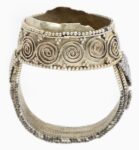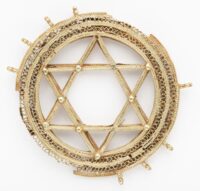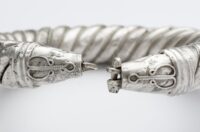 An exceptional hoard of 10th century jewelry that almost disappeared into the penumbra of online antiquities trafficking has gone on display for the first time at the Archaeological Museum of Córdoba. Its existence was only suspected last year when a local archaeologist saw photographs of some of the pieces for sale on social media and notified the National Police. The treasure was ostensibly discovered on La Amarguilla, a farm in the Andalusian town of Baena, southeast of Córdoba, but the story is self-serving with many glaring omissions.
An exceptional hoard of 10th century jewelry that almost disappeared into the penumbra of online antiquities trafficking has gone on display for the first time at the Archaeological Museum of Córdoba. Its existence was only suspected last year when a local archaeologist saw photographs of some of the pieces for sale on social media and notified the National Police. The treasure was ostensibly discovered on La Amarguilla, a farm in the Andalusian town of Baena, southeast of Córdoba, but the story is self-serving with many glaring omissions.
According to the experts consulted, the treasure was buried inside a bag or a ceramic container in the ground. Indeed, all of the pieces were stained by soil, indicating the treasure had been dug up only recently. The police investigation took place in the Córdoba municipalities of Lucena, Luque and Baena, where the treasure was finally found in an industrial warehouse. The person who had it in their possession took the police to an estate in Baena where they claimed to have found it.
However, the individual’s explanations regarding the original site of the buried treasure reportedly failed to convince archaeologists and consequently, no excavation has been undertaken to determine whether other elements are still to be discovered there.
 This is the 16th known jewelry hoard found in Andalusia and it stands out among them for the quality, quantity and rarity of its pieces. The Amarguilla Treasure is comprised of 623 jewels, beads and gems. There are 98 pieces of jewelry made of precious metal — gold, silver or gilt silver — of an unusual variety of designs. There are pendants, bracelets, hairpins, dress ornaments, rings of caliphal type, chains and broken necklaces. A large group of beads and pearls found in the hoard were originally part of the necklaces or bracelets. There are 17 hard stone (mostly quartz and rock crystal) beads, four cylindrical pink coral beads, 36 glass beads of different colors and 476 river seed pearls. No other documented Andalusian jewelry hoard contains any seed pearls.
This is the 16th known jewelry hoard found in Andalusia and it stands out among them for the quality, quantity and rarity of its pieces. The Amarguilla Treasure is comprised of 623 jewels, beads and gems. There are 98 pieces of jewelry made of precious metal — gold, silver or gilt silver — of an unusual variety of designs. There are pendants, bracelets, hairpins, dress ornaments, rings of caliphal type, chains and broken necklaces. A large group of beads and pearls found in the hoard were originally part of the necklaces or bracelets. There are 17 hard stone (mostly quartz and rock crystal) beads, four cylindrical pink coral beads, 36 glass beads of different colors and 476 river seed pearls. No other documented Andalusian jewelry hoard contains any seed pearls.
 Among the notable pieces are two intricate gold filigree pendants, one in a circular, one in a bell shape. Circular examples have been found before in hoards. The bell-shaped one is unique on the archaeological record. The greatest standout jewels are a circular pendant with the Star of David inside and two bangles, one silver, one gilt, with animal head terminals. The Star of David pendant is made with a filigree so delicate and precise that required great technical virtuosity from the goldsmith. It is unique; there is no other piece like it extant. The bangles are made of four twisted tubes silver with four threads twisted between them. The terminals are serpent heads constructed with very fine granulation.
Among the notable pieces are two intricate gold filigree pendants, one in a circular, one in a bell shape. Circular examples have been found before in hoards. The bell-shaped one is unique on the archaeological record. The greatest standout jewels are a circular pendant with the Star of David inside and two bangles, one silver, one gilt, with animal head terminals. The Star of David pendant is made with a filigree so delicate and precise that required great technical virtuosity from the goldsmith. It is unique; there is no other piece like it extant. The bangles are made of four twisted tubes silver with four threads twisted between them. The terminals are serpent heads constructed with very fine granulation.
 The style of the jewels dates them to the 10th century. It was likely buried in the beginning of the 11th century during the upheaval of the civil war that broke out in 1009 and would drag on for two decades and ultimately bring about the demise of the Caliphate of Córdoba. The other Andalusian hoards also include coins that made it possible to pin down the latest possible date they were buried. That this hoard does not strongly suggests they were surreptitiously sold before authorities got wind
The style of the jewels dates them to the 10th century. It was likely buried in the beginning of the 11th century during the upheaval of the civil war that broke out in 1009 and would drag on for two decades and ultimately bring about the demise of the Caliphate of Córdoba. The other Andalusian hoards also include coins that made it possible to pin down the latest possible date they were buried. That this hoard does not strongly suggests they were surreptitiously sold before authorities got wind  of the discovery. Coins are more common, making them easy to move because people don’t ask a lot of questions when they emerge on the market. The jewelry is extremely rare and much harder to sell without arousing suspicions, which is exactly how the Amarguilla treasure came to light in the first place.
of the discovery. Coins are more common, making them easy to move because people don’t ask a lot of questions when they emerge on the market. The jewelry is extremely rare and much harder to sell without arousing suspicions, which is exactly how the Amarguilla treasure came to light in the first place.
The Jewels of Amarguilla exhibition is temporary, running through June 6, 2021, but the treasure will go on permanent display at the museum.